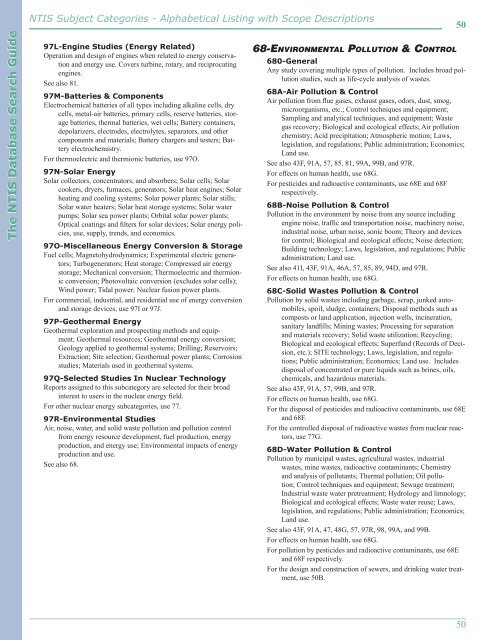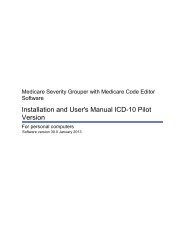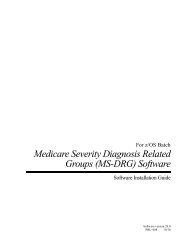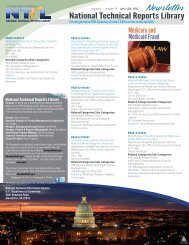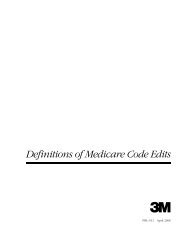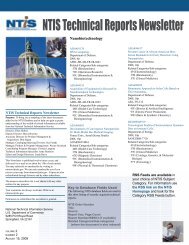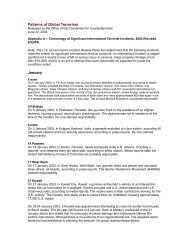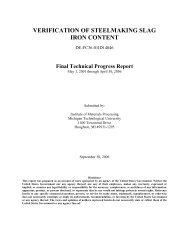DATABASE GUIDE - National Technical Information Service
DATABASE GUIDE - National Technical Information Service
DATABASE GUIDE - National Technical Information Service
You also want an ePaper? Increase the reach of your titles
YUMPU automatically turns print PDFs into web optimized ePapers that Google loves.
NTIS Subject Categories - Alphabetical Listing with Scope Descriptions5097L‐Engine Studies (Energy Related)Operation and design of engines when related to energy conservationand energy use. Covers turbine, rotary, and reciprocatingengines.See also 81.97M‐Batteries & ComponentsElectrochemical batteries of all types including alkaline cells, drycells, metal‐air batteries, primary cells, reserve batteries, storagebatteries, thermal batteries, wet cells; Battery containers,depolarizers, electrodes, electrolytes, separators, and othercomponents and materials; Battery chargers and testers; Batteryelectrochemistry.For thermoelectric and thermionic batteries, use 97O.97N‐Solar EnergySolar collectors, concentrators, and absorbers; Solar cells; Solarcookers, dryers, furnaces, generators; Solar heat engines; Solarheating and cooling systems; Solar power plants; Solar stills;Solar water heaters; Solar heat storage systems; Solar waterpumps; Solar sea power plants; Orbital solar power plants;Optical coatings and filters for solar devices; Solar energy policies,use, supply, trends, and economics.97O‐Miscellaneous Energy Conversion & StorageFuel cells; Magnetohydrodynamics; Experimental electric generators;Turbogenerators; Heat storage; Compressed air energystorage; Mechanical conversion; Thermoelectric and thermionicconversion; Photovoltaic conversion (excludes solar cells);Wind power; Tidal power; Nuclear fusion power plants.For commercial, industrial, and residential use of energy conversionand storage devices, use 97I or 97J.97P‐Geothermal EnergyGeothermal exploration and prospecting methods and equipment;Geothermal resources; Geothermal energy conversion;Geology applied to geothermal systems; Drilling; Reservoirs;Extraction; Site selection; Geothermal power plants; Corrosionstudies; Materials used in geothermal systems.97Q‐Selected Studies In Nuclear TechnologyReports assigned to this subcategory are selected for their broadinterest to users in the nuclear energy field.For other nuclear energy subcategories, use 77.97R‐Environmental StudiesAir, noise, water, and solid waste pollution and pollution controlfrom energy resource development, fuel production, energyproduction, and energy use; Environmental impacts of energyproduction and use.See also 68.68‐Environmental Pollution & Control680‐GeneralAny study covering multiple types of pollution. Includes broad pollutionstudies, such as life‐cycle analysis of wastes.68A‐Air Pollution & ControlAir pollution from flue gases, exhaust gases, odors, dust, smog,microorganisms, etc.; Control techniques and equipment;Sampling and analytical techniques, and equipment; Wastegas recovery; Biological and ecological effects; Air pollutionchemistry; Acid precipitation; Atmospheric motion; Laws,legislation, and regulations; Public administration; Economics;Land use.See also 43F, 91A, 57, 85, 81, 99A, 99B, and 97R.For effects on human health, use 68G.For pesticides and radioactive contaminants, use 68E and 68Frespectively.68B‐Noise Pollution & ControlPollution in the environment by noise from any source includingengine noise, traffic and transportation noise, machinery noise,industrial noise, urban noise, sonic boom; Theory and devicesfor control; Biological and ecological effects; Noise detection;Building technology; Laws, legislation, and regulations; Publicadministration; Land use.See also 41I, 43F, 91A, 46A, 57, 85, 89, 94D, and 97R.For effects on human health, use 68G.68C‐Solid Wastes Pollution & ControlPollution by solid wastes including garbage, scrap, junked automobiles,spoil, sludge, containers; Disposal methods such ascomposts or land application, injection wells, incineration,sanitary landfills; Mining wastes; Processing for separationand materials recovery; Solid waste utilization; Recycling;Biological and ecological effects; Superfund (Records of Decision,etc.); SITE technology; Laws, legislation, and regulations;Public administration; Economics; Land use. Includesdisposal of concentrated or pure liquids such as brines, oils,chemicals, and hazardous materials.See also 43F, 91A, 57, 99B, and 97R.For effects on human health, use 68G.For the disposal of pesticides and radioactive contaminants, use 68Eand 68F.For the controlled disposal of radioactive wastes from nuclear reactors,use 77G.68D‐Water Pollution & ControlPollution by municipal wastes, agricultural wastes, industrialwastes, mine wastes, radioactive contaminants; Chemistryand analysis of pollutants; Thermal pollution; Oil pollution;Control techniques and equipment; Sewage treatment;Industrial waste water pretreatment; Hydrology and limnology;Biological and ecological effects; Waste water reuse; Laws,legislation, and regulations; Public administration; Economics;Land use.See also 43F, 91A, 47, 48G, 57, 97R, 98, 99A, and 99B.For effects on human health, use 68G.For pollution by pesticides and radioactive contaminants, use 68Eand 68F respectively.For the design and construction of sewers, and drinking water treatment,use 50B.50


